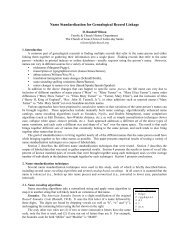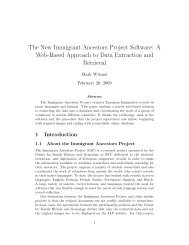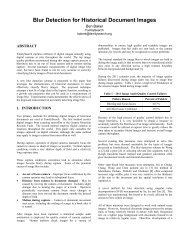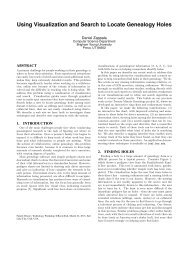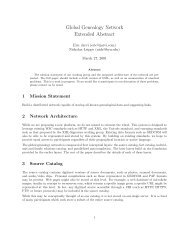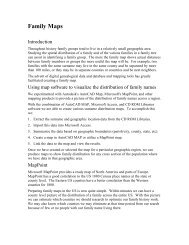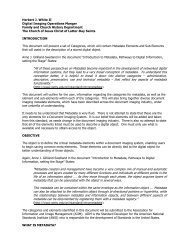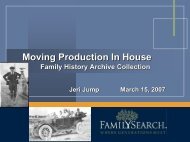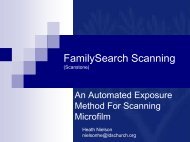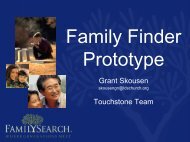Report Card for the Genealogy Software Industry
Report Card for the Genealogy Software Industry
Report Card for the Genealogy Software Industry
You also want an ePaper? Increase the reach of your titles
YUMPU automatically turns print PDFs into web optimized ePapers that Google loves.
A <strong>Report</strong> <strong>Card</strong> <strong>for</strong> <strong>the</strong> <strong>Genealogy</strong> <strong>Software</strong> <strong>Industry</strong> <br />
(We’re getting a D+) <br />
by <br />
Dan Lawyer, Joe Martel, Grant Skousen, Ron Tanner <br />
FamilySearch <br />
5 Mar 2010 <br />
<br />
1
Overview <br />
Recently FamilySearch per<strong>for</strong>med an analysis of how well <strong>the</strong> genealogical software <br />
industry is supporting individuals in <strong>the</strong>ir ef<strong>for</strong>ts to do family history. The net result <br />
of <strong>the</strong> analysis is that as an industry we are getting a D+. The study also suggests <br />
that <strong>the</strong>re are substantial opportunities <strong>for</strong> players in <strong>the</strong> industry to grow and <br />
differentiate in ways that will not only better meet <strong>the</strong> needs of current users but <br />
also increase <strong>the</strong> total number of people participating in family history. <br />
Grading <strong>the</strong> Genealogical <strong>Industry</strong> <br />
There are many different ways to approach grading <strong>the</strong> genealogical industry. This <br />
recent analysis focused on how well <strong>the</strong> industry meets <strong>the</strong> needs of individuals <br />
trying to do genealogy. In order to quantify this we measured <strong>the</strong> capability of <br />
leading desktop applications and online web sites in supporting an individual <br />
through <strong>the</strong> process of doing genealogy. In order to per<strong>for</strong>m <strong>the</strong> analysis we needed <br />
two items: 1) a definition of <strong>the</strong> process of genealogy that could be used as a basis <br />
<strong>for</strong> comparison 2) a list of leading applications and web sites. <br />
The list of leading applications and web sites consisted of 6 desktop applications <br />
and 3 websites. The criteria used to select <strong>the</strong> industry players consisted of a <br />
combination of market presence and momentum. In an ef<strong>for</strong>t not to draw criticism <br />
or attention to any particular vendor, we have chosen not to disclose <strong>the</strong> list of <br />
applications and sites (with <strong>the</strong> exception of those provided by FamilySearch: <br />
Personal Ancestral File and <strong>the</strong> new FamilySearch web site). As a result we are <br />
disclosing only <strong>the</strong> average results across all applications and sites included in <strong>the</strong> <br />
analysis and <strong>the</strong> specific results of Personal Ancestral File and <strong>the</strong> new FamilySearch <br />
web site. <br />
The Genealogical Workflow (explained more in <strong>the</strong> following section) covers a <br />
breadth of activities that a user per<strong>for</strong>ms as <strong>the</strong>y do genealogy. Some applications <br />
and web sites focus on a particular phase of <strong>the</strong> workflow while o<strong>the</strong>rs try to <br />
address it more broadly. The Genealogical Workflow was used as a basis of <br />
comparison <strong>for</strong> each of <strong>the</strong> applications and web sites on <strong>the</strong> list. Subject matter <br />
experts reviewed <strong>the</strong> applications and web sites against <strong>the</strong> elements of <strong>the</strong> <br />
Genealogical Workflow and awarded a score in each category. The applications and <br />
web sites were scored on a grade point average scale with 0 representing an F and 4 <br />
representing an A. Although our subject matter experts tried to be open-‐minded in <br />
<strong>the</strong>ir analysis, <strong>the</strong> methodology can only be characterized as a subjective analysis. <br />
The Genealogical Workflow <br />
The Genealogical Workflow is an artifact of a contextual inquiry and contextual <br />
design process (CI/CD) , a process used by FamilySearch to understand <strong>the</strong> needs of <br />
individuals doing genealogy. More in<strong>for</strong>mation about CI/CD can be found on <br />
Wikipedia.org (http://en.wikipedia.org/wiki/Contextual_design). One of <strong>the</strong> <br />
valuable tools created by this CI/CD process is called a consolidated workflow. A <br />
consolidated workflow is created by observing people per<strong>for</strong>ming an activity and <br />
<br />
2
<strong>the</strong>n carefully documenting <strong>the</strong> process <strong>the</strong>y go through to per<strong>for</strong>m <strong>the</strong> particular <br />
job or task being observed. The results of <strong>the</strong> observation are <strong>the</strong>n combined or <br />
consolidated into one workflow representing <strong>the</strong> composite observations of many <br />
people. The Genealogical Workflow shown below is <strong>the</strong> result of more than 60 such <br />
observations of persons located in different countries worldwide doing genealogy. A <br />
more detailed version of <strong>the</strong> Genealogical Workflow can be found in Appendix A. <br />
One interesting way to analyze <strong>the</strong> Genealogical Workflow is to correlate it to <strong>the</strong> <br />
Genealogical Proof Standard adopted by <strong>the</strong> Board <strong>for</strong> <strong>the</strong> Certification of <br />
Genealogists. The Genealogical Proof Standard is a standard that can be used to <br />
judge <strong>the</strong> credibility of a genealogical conclusion based on <strong>the</strong> following elements: <br />
• a reasonably exhaustive search <br />
• complete and accurate source citations; <br />
• analysis and correlation of <strong>the</strong> collected in<strong>for</strong>mation; <br />
• resolution of any conflicting evidence; and <br />
• a soundly reasoned, coherently written conclusion <br />
More in<strong>for</strong>mation about <strong>the</strong> Genealogical Proof Standard can be found here: <br />
http://www.bcgcertification.org/resources/standard.html. <br />
The workflow has five major phases represented as circles in <strong>the</strong> chart above. These <br />
phases and <strong>the</strong>ir relationship to <strong>the</strong> Genealogical Proof Standard are described in <br />
<strong>the</strong> following list. <br />
1. Decide what to do. During this phase an individual must decide what to do. <br />
This often involves <strong>for</strong>mally or in<strong>for</strong>mally setting a research objective, plan <br />
<br />
3
and strategy. The outcome of this phase has a correlation to <strong>the</strong> likelihood of <br />
an individual per<strong>for</strong>ming an exhaustive search as recommended in <strong>the</strong> <br />
Genealogical Proof Standard. <br />
2. Ga<strong>the</strong>r. In software systems <strong>the</strong> Ga<strong>the</strong>r phase is tightly related with search. It <br />
is also where in<strong>for</strong>mation is captured. This is <strong>the</strong> phase where an exhaustive <br />
search is per<strong>for</strong>med. It is also where source citations must be captured and <br />
where some analysis occurs as described by <strong>the</strong> Genealogical Proof Standard. <br />
3. Analyze. During <strong>the</strong> analyze phase evidence is evaluated, conflicting evidence <br />
is resolved, conclusions are <strong>for</strong>med and an explanation is created. Individuals <br />
often bounce back and <strong>for</strong>th between <strong>the</strong> Analyze and Ga<strong>the</strong>r phases. At <br />
times this occurs very quickly. The analysis, dealing with conflicting evidence <br />
and explanation of conclusions are aspects of <strong>the</strong> Genealogical Proof <br />
Standard which happen during this phase. <br />
4. Incorporate. Once conclusions and explanations are created, <strong>the</strong> conclusions, <br />
explanations and evidence can be incorporated into <strong>the</strong> genealogical record <br />
or tree. Often additional analysis is required as new in<strong>for</strong>mation is merged in <br />
and carrying <strong>for</strong>ward <strong>the</strong> evidence, citations and explanations is essential. <br />
The incorporation of evidence, citations and explanations and <strong>the</strong> additional <br />
analysis which occurs in this phase are all elements of <strong>the</strong> Genealogical Proof <br />
Standard. <br />
5. Collaborate. Throughout <strong>the</strong> Genealogical Workflow individuals have a need <br />
to collaborate with one ano<strong>the</strong>r. This collaboration may be with peers, <br />
mentors, friends, family or complete strangers. <br />
A series of articles describing <strong>the</strong>se phases is currently being published on <strong>the</strong> <br />
FamilySearch Labs blog. Articles about <strong>the</strong> first two phases have already been <br />
published and can be found at <strong>the</strong> following URLs: <br />
• http://labs.familysearch.org/blog/?p=436 <br />
• http://labs.familysearch.org/blog/?p=460 <br />
<strong>Industry</strong> Analysis <br />
If <strong>the</strong> desktop applications and web sites used in this analysis are indeed <br />
representative of <strong>the</strong> best <strong>the</strong> genealogical industry has to offer <strong>the</strong>n <strong>the</strong> average <br />
grade <strong>for</strong> our industry is a D+. We aren’t failing nor are we excelling. The table <br />
below summarizes <strong>the</strong> results of <strong>the</strong> analysis. A more detailed table containing a <br />
complete break out of all <strong>the</strong> sub-‐categories that were analyzed can be found in <br />
Appendix B. <br />
Phase PAF new FamilySearch <strong>Industry</strong> Avg. <br />
Decide What to Do 0 2 1.2 <br />
Ga<strong>the</strong>r 1 1 1.6 <br />
Analyze 0 1 1.4 <br />
Incorporate 1 2 1.8 <br />
Collaborate 0 1 1.0 <br />
Overall: 0.4 1.4 1.4 <br />
<br />
4
Raising Our Grade <br />
Given <strong>the</strong> results of <strong>the</strong> analysis, <strong>the</strong> question must be asked, “What can we do to <br />
raise our grade?” We would like to propose three things FamilySearch and vendors <br />
might do to improve <strong>the</strong> score. <br />
1. Do a self-‐scored test to see how your application or web site is standing up to <br />
<strong>the</strong> industry average.. <br />
2. Use <strong>the</strong> self-‐scored test to determine opportunities <strong>for</strong> you to improve your <br />
application or site support of <strong>the</strong> Genealogical Workflow process of doing <br />
genealogy. <br />
3. Consider a strategy that more broadly supports <strong>the</strong> entire genealogical <br />
workflow or alternatively, a strategy that allows you to excel at a particular <br />
phase in <strong>the</strong> workflow. The analysis shows that <strong>the</strong>re are consistent <br />
weaknesses across <strong>the</strong> industry in all phases of <strong>the</strong> workflow with a greater <br />
need in <strong>the</strong> Collaboration, Decide What to Do and Analyze phases. These <br />
represent opportunities <strong>for</strong> <strong>the</strong> industry. <br />
Conclusion <br />
In conclusion, <strong>the</strong> process an individual must go through to do genealogy is complex <br />
and difficult. Substantial ef<strong>for</strong>t has been made by <strong>the</strong> genealogical industry to <br />
provide tools that facilitate and simplify this process. While much progress has been <br />
made, this analysis suggests that on average we are slightly below average at really <br />
meeting <strong>the</strong> needs of those trying to do family history. There are still substantial <br />
opportunities <strong>for</strong> improvement that translate into more individuals participating in <br />
family history, more ancestors being found and more opportunities <strong>for</strong> commercial <br />
vendors. <br />
<br />
5
Appendix A: Genealogical Workflow <br />
<br />
6
Appendix B: <strong>Industry</strong> Analysis <br />
Genealogical Workflow <br />
Support -‐ Product Scorecard <br />
Products <br />
1 <br />
2 <br />
3 <br />
4 <br />
5 <br />
6 <br />
7 <br />
8 <br />
9 <br />
Phase and Tasks <br />
All <br />
Lots to do 0 1 0 0 0 0 2 3 3 <br />
bounce between core phases 0 0 0 2 0 0 1 2 1 <br />
I’m smarter, learned new <br />
trick/tool/process/hint 0 0 0 1 0 0 1 2 2 <br />
subjective phase summary 0 0 0 1 0 0 2 3 3 <br />
Entry <br />
What's new? 0 0 0 0 0 3 0 4 4 <br />
Invite 0 0 0 0 0 3 0 0 0 <br />
subjective phase summary 0 0 0 0 0 3 0 3 3 <br />
Decide What to do <br />
What do I already know? 0 0 0 1 0 0 1 1 1 <br />
What artifacts do I have? *1 1 1 1 0 0 0 0 1 1 <br />
What do relatives know? 0 0 0 0 0 1 0 0 1 <br />
What do o<strong>the</strong>r sources know? 0 0 0 2 0 0 2 4 4 <br />
Where do I go? 0 0 0 2 0 2 3 4 4 <br />
What should I do? 0 1 1 2 0 0 2 4 4 <br />
subjective phase summary 0 0 0 2 0 1 2 3 3 <br />
Ga<strong>the</strong>r <br />
<strong>Report</strong>s, copy to use in field 2 3 3 0 0 0 4 4 4 <br />
Visit Website, person, relative, place 0 0 0 0 0 0 2 3 3 <br />
Search <strong>for</strong> sources, info 0 1 0 0 1 0 1 3 3 <br />
-‐ Re-‐search <strong>for</strong> new info*1,3 0 2 1 2 0 0 2 2 2 <br />
-‐ Exhaustive search *1 0 0 0 1 0 0 2 2 3 <br />
Discover, see sources 0 2 0 1 1 0 1 2 2 <br />
Need to get film book, site access 0 0 0 0 0 0 0 0 0 <br />
Decide if I want to capture 0 0 1 0 1 0 1 2 2 <br />
-‐ unsure, future fodder, lead <strong>for</strong> o<strong>the</strong>rs 0 0 0 0 0 0 0 4 4 <br />
-‐ Filter out 0 0 0 0 1 0 0 2 2 <br />
Capture source (photocopy, link) 1 1 1 0 1 0 1 4 4 <br />
" 0 0 0 0 0 0 0 2 2 <br />
Capture source citation *2 1 1 1 0 1 0 2 4 4 <br />
Annotate <strong>the</strong> source 0 0 0 0 0 0 0 4 4 <br />
Make a <strong>the</strong>ory *4 0 0 0 0 0 0 0 2 2 <br />
subjective phase summary 1 2 1 1 1 0 2 3 3 <br />
Analyze <br />
Analyze, compare, juggle *3,4 1 2 1 2 3 0 3 3 3 <br />
" Compare to mine, new *3 0 2 1 1 3 0 3 3 3 <br />
Annotate <strong>the</strong> source with notes *5 0 0 0 0 0 0 1 3 3 <br />
Decide usefulness 0 0 0 0 0 0 0 2 2 <br />
-‐ Use it *5 0 0 0 0 1 0 1 4 4 <br />
-‐ Theorize *4 0 0 0 0 0 0 0 2 2 <br />
-‐ Trash it 0 0 0 0 1 0 0 1 1 <br />
<br />
7
Use helpers (translate, expert, research) 0 1 0 0 0 0 1 2 2 <br />
Track my process, did this/that 0 0 0 0 1 1 0 2 2 <br />
subjective phase summary 0 1 0 1 2 0 3 3 3 <br />
Incorporate <br />
Consult with o<strong>the</strong>rs, ask <strong>for</strong> help 0 0 0 0 0 1 2 1 1 <br />
Create/edit/recover conclusion 2 2 2 1 2 1 2 3 3 <br />
-‐ Merge in new info*3, gedcom from <br />
o<strong>the</strong>r 0 2 0 2 3 1 4 4 4 <br />
-‐ updating public data 0 1 1 1 0 1 1 0 0 <br />
-‐ updating private data 2 2 2 1 1 1 2 3 3 <br />
-‐ Reference source & citation *2 2 2 2 2 1 0 2 3 4 <br />
-‐ Preserve source/evidence *2 1 1 1 0 0 0 1 4 4 <br />
-‐ Explain *5 2 2 2 1 0 0 1 2 2 <br />
-‐ Not sure yet, Theorize *3,4 0 0 0 0 0 0 0 2 2 <br />
-‐ Ask <strong>for</strong> approval 0 0 0 0 0 0 0 0 0 <br />
Share/Publish to o<strong>the</strong>rs (seeCollaborate) -‐ -‐ -‐ -‐ -‐ -‐ -‐ -‐ -‐ <br />
subjective phase summary 1 2 1 2 1 1 2 3 3 <br />
Collaborate/Help <br />
I have a problem 0 0 0 0 1 1 1 2 2 <br />
Ask <strong>for</strong> help (expert, local, skill, relative) 0 0 1 1 0 0 2 1 2 <br />
Receive help/Info 0 0 1 1 0 0 2 1 2 <br />
Share/Publish to o<strong>the</strong>rs 0 1 1 2 1 2 2 1 3 <br />
" 0 0 0 1 0 3 0 0 2 <br />
" 0 0 0 1 0 1 0 0 2 <br />
Work with o<strong>the</strong>rs 0 0 1 0 0 1 2 1 2 <br />
Invite, viral 0 0 0 0 0 3 0 1 1 <br />
Google-‐able content 0 0 0 0 0 0 0 0 0 <br />
Need a referral to a helper 0 0 0 0 0 0 0 0 0 <br />
O<strong>the</strong>r agrees to help me 0 0 0 0 0 0 0 0 0 <br />
Prove my worthiness to gain trust 0 0 0 0 0 0 0 0 0 <br />
Give <strong>the</strong> helper info to help me 0 0 0 0 0 0 1 0 0 <br />
subjective phase summary 0 0 1 1 0 2 2 1 2 <br />
overall summary 0.4 1.0 0.6 1.4 0.8 0.8 2.2 2.6 2.8 <br />
*Genealogical proof standard item <br />
1. Exhaustive Search <br />
2. Source Citations <br />
3. Analysis of evidence w/conclusion <br />
4. Conflicting evidence <br />
5. Conclusion explanation <br />
<br />
8





